
|   |

|   |
9th edition of Nrityakalpa - Dr. Jintu Sarma e-mail: jsarma88@gmail.com Photos: Samir Kar February 5, 2020 Saptaswa celebrated its 9th edition of Nrityakalpa (a national festival of Indian classical dance and music) on 11th and 12th January 2020 in the auditorium of District Library of cultural hub, Tezpur. As per tradition, the first day's program began with a Gayan Bayan performed by the students of Srijani Sangeet Mahavidyalaya, Tezpur. Gayan-Bayan is a traditional performance of the Vaishnava Sattriya tradition. The performers were Jigyasita Garg, Nilangana Bora, Nirikhya Deka, Kripashree Dutta Hazarika, Azra Kayum, Nikita Kakati, Parinita Bharali, Chandrakhyi Mahanta and Duwari Borah. The item was directed by Sattriya exponent Mitali Dutta Borthakur. 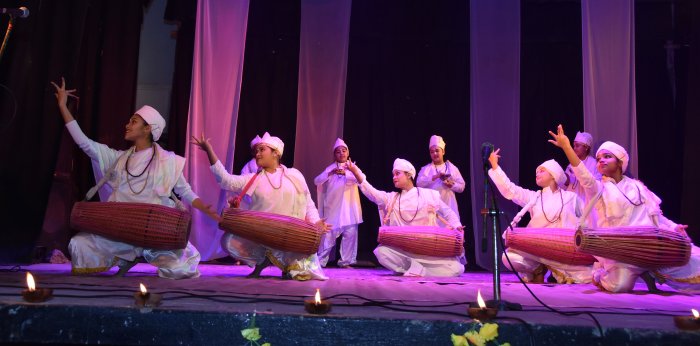 Gayan Bayan 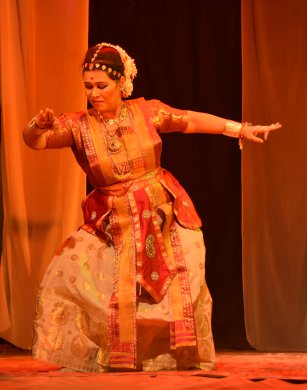 Dr. Pratibha Sharma 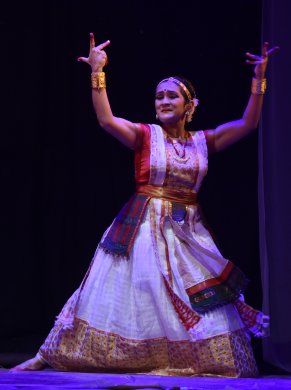 Dr. Meernanda Borthakur Dr. Pratibha Sharma, backbone of the festival and general secretary of Saptaswa, presented her recital in two phases. She started her programme with a pure Sutradhari Nach followed by Ahalya Udhar, a composition based on the Ramayana. After that her disciples Meghmallika Bora, Swati Bayan, Krishtina Pujari and Sampriti Bora presented a Sattriya recital Brindaban Bihar based on first Skanda of Srimad Bhagawat and a portion of Borgeet of Shri Madhavdev. Both the compositions were directed by Nrityacharya Jatin Goswami, with music by Dhrubajyoti Boruah. Kathak was presented by Sourav Roy from Kolkata. Sourav started his initial training in dance under the guidance of Gautam Sengupta of Siliguri. For the last two decades he is under the tutelage of Kathak Guru Dr. Malabika Mitra. He started his performance with a Ganesh Vandana followed by traditional Kathak in taal Dhamar. In abhinaya on Meera Bhajan, he presented the character of Draupadi in a graceful manner. His performance ended with a tarana in teen taal and raag Malkauns. He impressed the audience with his skills. Dr. Meernanda Borthakur from Guwahati starting her training in Sattriya dance under Guru Gobinda Saikia; since 1999 she is under the guidance of Guru Jatin Goswami. By profession Dr. Borthakur is a dental surgeon. She presented a traditional Rojagharia Sali Nach and then a soulful abhinaya on Usha-Chitralekha, a conversation between them regarding Usha's dream of Anirudha. 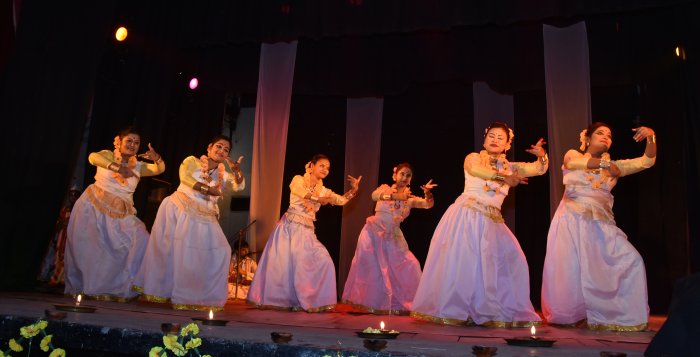 Devadasi dance This was followed by a traditional Devadasi dance. Srimanta Sankaradeva mentioned that he had seen this special dance form in the temple of Sri Sri Jagannatha. In Assam, the culture of Devadasi was found in Parihareswar temple, Dubi, which is reflected by Bhaskaravarman in his metal scripts and as per that the tradition of Devadasi is at least 1420 years old. History shows that during the Ahom dynasty, this traditional dance form was also practised in the Baneswar temple of Biswanath and Negheriting temple of Golaghat. For practising the dance, the king created some ranks like Gayan Baruah, Bayan Baruah, Sattriya Baruah etc. Now, in this modern era there is no culture of Devadasi but it has a bright history. Ancient texts like the Kalika Purana and Jogitantra also carry references to this ritualistic dance practice. To invigorate this elapsed history, Saptaswa presented a brilliant Devadasi performance by Meghmallika Bora, Swati Bayan, Krishtina Pujari, Sampriti Bora, Darshana Priyam Deka and Mayurakskhi Das, directed by Dr. Pratibha Sharma. Accompanying artists were Ranjan Bora on khol, Dr. Sonit Mahanta on violin and Hirak Nath on flute. The first day's program concluded with a Bhortaal Nritya. It is an extension of Sankari culture. A large number of dancers equipped with large cymbals (bhortaal) perform this dance to the first bit of 'Thiya Nam' and produce a good number of attractive formations displaying the cymbals. Bhortaal Nritya evolved from the classical dance form Sattriya of Barpeta district of Assam and was developed by Narahari Burha Bakat, a well-known Sattriya promoter. It is performed in a group of six or seven dancers or sometimes in even larger groups, in praise of god. The item was presented by the junior students of Saptaswa. 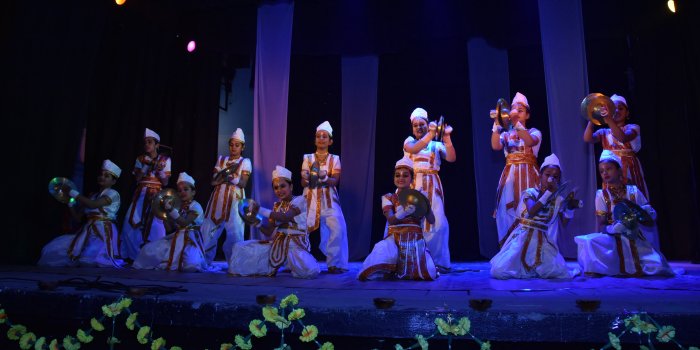 Bhortaal Nritya 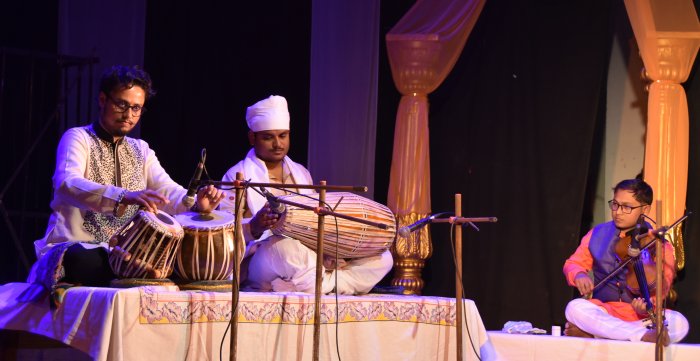 Manoj Kumar Das and Dhriti Gobinda Dutta The program on day two began with a jugalbandi of khol and tabla performed by Manoj Kumar Das and Dhriti Gobinda Dutta. For his exceptional skill in Khol Vadya, Ministry of Culture, Govt of India provided Manoj the National Young Artist Scholarship Award in 2014 and Junior Research Fellowship in 2017. Sangeet Natak Akademi awarded him Ustad Bismillah Khan Yuva Puraskar for 2018 in traditional music section, for the first time in khol. Dhriti from Guwahati is a disciple of tabla maestro Pt. Anindo Chatterjee. Accompanied by Manjil Kumar Gogoi on violin, the duo mesmerized the audience with their music. Sattriya dancer Ranjan Kumar Bora from Majuli, is a disciple of Haricharan Bhuyan Borbayan, Nagen Bargayan, and Padma Pathak. He began with a shloka on Geeta Govindam followed by Gosaiprabeshar Nach, abhinaya for a borgeet of Madhavdev 'Mohana Bawataxururi re kanu'. Music was by Prateesha Suresh. Ranjan received rousing appreciation from the audience. Odissi was performed by the artists of Kashinath Krishna Priya Institute of Performing Art. They started with a composition from Tulsidas's Ramcharita Manas depicting Ram's beauty when first witnessed by sakhis in Pushpa Udyan. Performed by Debarathi Saha and Prachi Sharma, the item was choreographed by Dr. Madurima Goswami, with music by Bankim Sethi. Next was a pure nritta item performed in fast tempo presented by Madhusmriti Bishaya, Asmita Bhaowal, Bishal Dawka, Keshab Das, Pahi Goswami, Jyotisma Patangia. Choreography was by Dr. Madhurima Goswami, composition by Guru Mayadhar Raut and music by Bankim Sethi. Bharatanatyam was presented by Dr. Mandakranta Roy from Tripura. Dr. Roy is a disciple of Prof. C. V. Chandrasekhar and Sujata Ramalingam and has a doctorate in Botany. Roy began with a Thodayamangalam choreographed by her. The beautiful piece was composed by Annamacharya where the devotee praises the superlative qualities of LordVishnu. Written by Vyasatirtha in Kannada language, "Krishna nee begane baro" in ragam Yaman Kalyani and talam mishra chapu was choreographed by Guru Thankamani Kutty. This is a pure abhinaya piece and the story is about mother Yashoda and her little child Krishna. She concluded with a shlokam in Ragamalika and Talamalika, choreographed by Guru Khagendra Nath Barman. In this the devotee recollects the story of Samudra Manthan. She describes how the almighty Lord Shiva saved the whole universe by holding the poison halahal in his throat. She praises the almighty Mahadev as the divine and beautiful one, as destroyer, as Tandavaya, the creator of dance. The audience enjoyed the beauty of Bharatanatyam through Dr. Roy's performance. 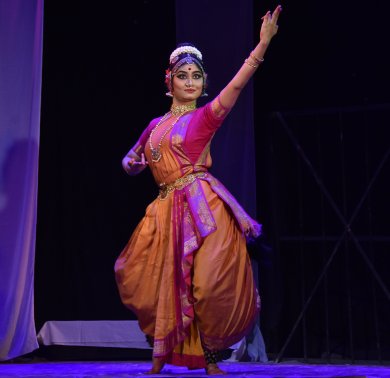 Dr. Mandakranta Roy Then junior students of Saptaswa presented Matiakhara, Krishna Nritya and Jhumura Nach. The program concluded with 'Sonit Kuwari' written by Rupkonwar Jyotiprasad Agarwala at age of 14 in 1924. This was presented in Sattriya style by artists of Saptaswa with concept and direction by Dr. Pratibha Sharma, music by Ranjan Bora, sets by Prafulla Bora and lights by Bipul Nath. The fine acting skills of the cast was well received by the houseful audience. Hope Saptaswa will present such quality productions in future too. |